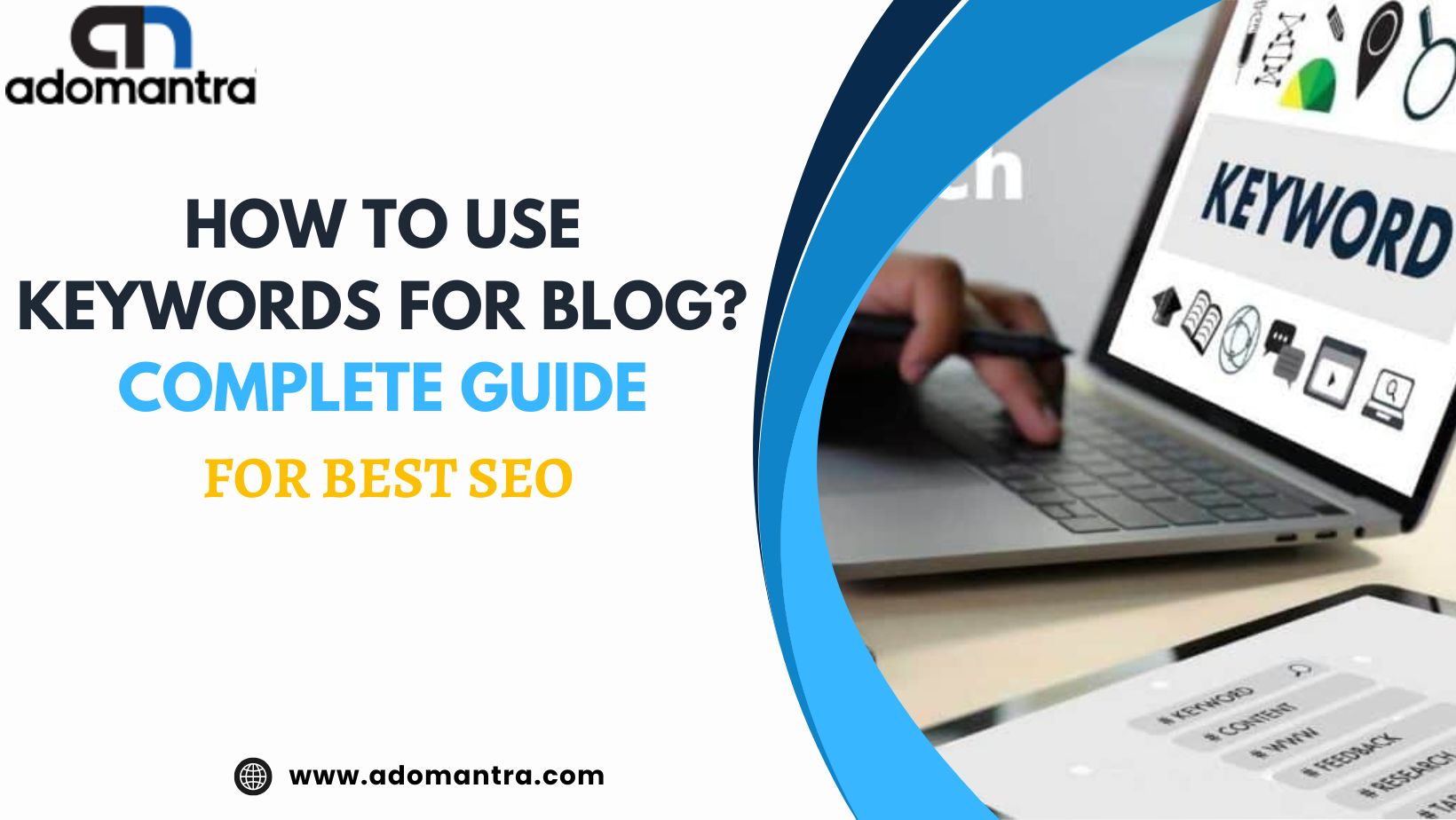
How to Use Keywords for Blog? | Complete Guide For Best SEO
Using keywords effectively in your blog is crucial for optimizing your content for search engines and improving your blog's SEO (Search Engine Optimization). Here's a complete guide on how to use keywords for your blog:
- Keyword Research: Start by conducting thorough keyword research to identify relevant and high-traffic keywords related to your blog topic. Use tools like Google Keyword Planner, SEMrush, Ahrefs, or Ubersuggest to find relevant keywords.
- Long-tail Keywords: While targeting popular short keywords is important, also focus on long-tail keywords (more specific phrases containing multiple words). Long-tail keywords often have less competition and can drive more targeted traffic to your blog.
- Keyword Placement: Place your chosen keywords strategically in the following areas of your blog post:
- Title: Include your main keyword in the title, preferably towards the beginning.
- URL: Incorporate the main keyword in the URL slug.
- Headings and Subheadings: Use keywords in subheadings (H2, H3 tags) to break up content and make it more scannable.
- Introduction: Include your main keyword naturally in the introduction of your blog post.
- Throughout the Content: Sprinkle relevant keywords naturally throughout the content, but avoid keyword stuffing. Aim for a natural flow.
- Conclusion: If possible, mention your main keyword in the conclusion.
- Keyword Density: Keyword density refers to the percentage of times your keyword appears in relation to the total word count of the article. Aim for a keyword density of around 1-2%. Focus on providing high-quality content that serves the reader rather than obsessing over keyword density.
- Synonyms and Variations: Use synonyms and variations of your target keyword to make your content more natural and diverse. This also helps capture different search intents related to your topic.
- Image Alt Text: If your blog includes images, add descriptive alt text that includes your target keyword. This can improve your chances of ranking in image search results.
- Meta Tags: Write a compelling meta title and meta description for your blog post that includes your main keyword. These are the snippets that appear in search engine results, so they should be engaging and relevant.
- Internal and External Links: Incorporate internal links to other relevant posts on your blog and external links to authoritative sources. This improves the credibility and depth of your content, which search engines appreciate.
- User-Friendly Content: Prioritize writing high-quality, informative, and engaging content that meets the needs of your target audience. The more valuable your content, the more likely it is to rank well.
- Mobile-Friendly and Fast-loading: Ensure your blog is responsive and mobile-friendly. Additionally, optimize your site's loading speed, as it's a ranking factor for search engines.
- Regular Updates: Search engines tend to favor fresh and updated content. Periodically update your blog posts with new information to keep them relevant and current.
- Monitor and Adjust: Use tools like Google Analytics and Search Console to monitor your blog's performance. Analyze which keywords are driving traffic and adjust your strategy accordingly.
Importance of Keyword for a blog post
Keywords are crucial for a blog post's success because they play a significant role in improving the visibility, relevance, and search engine ranking of your content. Here's why keywords are important for a blog post:
- Search Engine Visibility: Keywords are the terms and phrases that people use when searching for information online. By strategically incorporating relevant keywords into your blog post, you increase the chances of your content appearing in search engine results when users search for those specific terms.
- Organic Traffic: Well-optimized content with the right keywords can attract organic (unpaid) traffic to your blog. When your content ranks higher in search results, more people are likely to click on your link and visit your blog, increasing your overall website traffic.
- Relevance: Keywords help search engines understand the topic and theme of your blog post. When your content is closely aligned with the keywords you're targeting, it becomes more relevant to the search queries, leading to better user experience and higher engagement.
- Targeted Audience: Properly chosen keywords help you connect with your target audience. By understanding the keywords your audience is using, you can tailor your content to their specific needs, interests, and questions.
- Ranking Improvement: Effective keyword usage can improve your blog post's search engine ranking. When search engines recognize that your content is relevant and valuable to users' queries, they are more likely to rank it higher in search results, increasing its visibility.
- Click-Through Rate (CTR): Appealing and relevant keywords in your meta title and description can lead to a higher click-through rate. A well-crafted meta title and description can entice users to click on your link instead of others in the search results.
- User Intent: Keywords indicate user intent. By researching keywords, you gain insight into what users are looking for and what information they expect from your blog post. This allows you to create content that fulfills their needs and answers their questions.
- Competitive Advantage: Proper keyword research can uncover opportunities in your niche. Finding keywords that are relevant but have lower competition can give you an advantage in ranking over more competitive terms.
- Content Structure: Keywords can guide the structure of your content. They can help you organize your ideas and create subheadings that make your content more scannable and user-friendly.
- Long-Term Benefits: Once your content ranks well for certain keywords, it can continue to attract traffic over time, even without ongoing promotion. This can provide a steady stream of visitors and potential customers to your blog.
There are four types of search intent that you should consider while finding keywords for a blog post
Absolutely, considering different types of search intent is essential when finding keywords for your blog post. Search intent refers to the reason behind a user's search query – what they are looking to achieve with their search. By understanding and targeting different types of search intent, you can create content that best matches users' needs. Here are the four main types of search intent to consider:
- Informational Intent: In this type of search intent, users are seeking information or answers to their questions. They want to learn something new or gain knowledge about a particular topic. Keywords that often indicate informational intent include phrases like "how to," "what is," "tips for," "benefits of," and "guide to."
- Example keyword: "How to start a vegetable garden"
- Content for informational intent should provide detailed explanations, step-by-step guides, and comprehensive answers to users' queries.
- Navigational Intent: Navigational intent searches occur when users are looking for a specific website, brand, or online destination. They have a clear destination in mind and are using search engines to find the quickest route there. Keywords indicating navigational intent might include brand names, product names, or specific website names.
- Example keyword: "Facebook login"
- While you might not directly target navigational intent keywords for your blog post, understanding them helps you understand what users might be looking for when they're searching for a specific website or online service.
- Transactional Intent: Users with transactional intent are ready to take a specific action, such as making a purchase, signing up for a service, or downloading a resource. These searches are more commercially oriented, and keywords often include phrases like "buy," "purchase," "discount," "coupon," and "best price."
- Example keyword: "Buy iPhone 12 online"
- Content targeting transactional intent should include product details, pricing, availability, and a clear call to action for users to take the desired action.
- Commercial Investigation (Investigational) Intent: This type of intent lies between informational and transactional intent. Users in the investigational stage are researching products or services before making a purchase decision. They want to compare options, read reviews, and gather more information about their potential choices.
- Example keyword: "Best laptops for video editing"
Content for investigational intent should provide comparisons, reviews, pros and cons, and detailed insights to help users make informed decisions.
Do’s & Don’ts on how to use keywords to optimise your blog.
Certainly, here are some do's and don'ts for effectively using keywords to optimize your blog content for search engines:
Do's:
- Do Conduct Keyword Research: Research relevant keywords using tools like Google Keyword Planner, SEMrush, or Ahrefs to identify high-traffic and low-competition keywords related to your topic.
- Do Use Long-Tail Keywords: Incorporate long-tail keywords to target specific user queries and capture niche audiences.
- Do Prioritize Relevance: Ensure that the keywords you choose are closely related to the content of your blog post. Relevance is key for both user satisfaction and search engine ranking.
- Do Use Keywords Naturally: Integrate keywords organically into your content so that it flows naturally and doesn't sound forced or awkward. Focus on readability and user experience.
- Do Include Keywords in Key Elements:
- Title: Place the main keyword near the beginning of the title.
- URL: Use the keyword in the URL slug.
- Headings: Include keywords in subheadings (H2, H3) for better structure.
- Introduction: Incorporate the keyword naturally in the opening paragraph.
- Do Write High-Quality Content: Create valuable, informative, and engaging content that addresses the user's needs and provides in-depth information on the topic.
- Do Use Synonyms and Variations: Include synonyms and related terms to diversify your content and capture different search intents.
- Do Optimize Images: Use relevant keywords in image alt text to improve accessibility and SEO for image searches.
- Do Build Internal and External Links: Include links to relevant internal pages within your blog and authoritative external sources to enhance the credibility and value of your content.
- Do Create Engaging Meta Tags: Craft compelling meta titles and descriptions that include your target keywords and encourage users to click through from search results.
Don'ts:
- Don't Keyword Stuff: Avoid overusing keywords, known as keyword stuffing. This not only hampers readability but can also lead to search engine penalties.
- Don't Sacrifice Quality for Keywords: While keywords are important, prioritize creating high-quality content that offers value to your readers. Don't compromise content quality for the sake of keyword optimization.
- Don't Use Irrelevant Keywords: Avoid using keywords that don't accurately reflect the content of your blog post. Misleading keywords can lead to high bounce rates and lower search engine rankings.
- Don't Rely Only on Exact Match Keywords: Incorporate variations and related terms rather than relying solely on exact match keywords. This helps diversify your content and capture a broader range of search queries.
- Don't Forget User Experience: Keep the user experience in mind. Ensure that your content is easy to read, navigate, and understand, regardless of keyword usage.
- Don't Ignore User Intent: Understand the intent behind the keywords you're targeting and tailor your content to match that intent. Failing to address user needs can result in lower engagement.
- Don't Neglect Mobile Optimization: Ensure your blog is responsive and mobile-friendly for a seamless user experience on different devices.
- Don't Neglect Updates: Regularly update your blog posts with new information to keep them relevant and up-to-date.
Conclusion
Keywords are and will continue to be an essential factor but the strategy of how an individual can utilise it throughout the content will evolve. Earlier SEOs used to stuff keywords in the content, and Google used to rank them directly without any relevance. But nowadays, the practice has changed, user intent & content quality matter more than keyword stuffing. But, here also, the idea remains the same; your blog post needs to have that search query or semantic Keyword to hint google that your blog post contains keywords that satisfy user queries.







